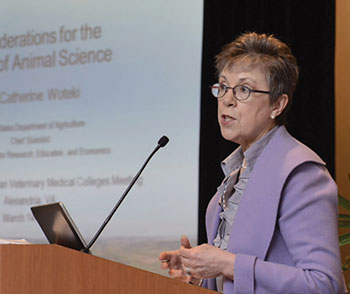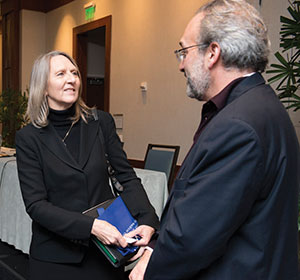One health in action
The one-health movement has been gathering momentum for almost a decade, and a number of organizations and interest groups have taken up the mantle and implemented the concept in different ways.
The one-health concept is a broad one that unites veterinarians, physicians, and other scientific, health, and environmental professionals in a collaborative approach that recognizes the vast interrelationships between human, animal, and environmental health.

The Association of American Veterinary Medical Colleges’ Annual Conference, March 14-16 in Alexandria, Va., had a theme of “One health in veterinary medical education” to highlight the work being done in this area. Ninety leaders from academic veterinary medicine and related disciplines gave 60 presentations that touched on topics such as controlling zoonotic infectious diseases, protecting the global food supply, improving clinical care for people and animals, and strategies for developing academic programs in one health.
“We live in the age of globalization, and one-health approaches to medicine and wellness are more important than ever before,” said AAVMC executive director Dr. Andrew Maccabe. “With its multispecies approach and broad spectrum of biomedical activity, veterinary medicine is uniquely qualified to lead in this area. We hope this meeting will be a catalyzing event in the evolution of this critical initiative.”
Research in progress
Keynote addresses were given by Dr. Juan Lubroth, chief veterinary officer of the United Nations Food and Agriculture Organization, and Catherine Wotecki, PhD, chief scientist and undersecretary for research, education, and economics with the Department of Agriculture.
Dr. Wotecki said pressing challenges that can be addressed by one health are population growth and demand for food and other products. She questioned whether a healthy diet will be sustainable in the long term when there’s an increasing demand for animal protein, especially as developing countries transition. Sustainable food security requires more investment in food science research, Dr. Wotecki said, particularly regarding food safety.
She noted that the recent Farm Bill is one health–focused, with new provisions that include establishing the Foundation for Food and Agriculture Research, which will provide $200 million in funding for new research projects aimed at addressing key problems of national and international importance.

Veterinary schools and their universities have, too, been encouraging more research in one-health areas.
Iowa State University is creating opportunities for researchers to apply their expertise and integrate education and outreach through its Health Research Initiative. Last year, the ISU-HRI funded 12 projects that cover topics impacting the health of humans, animals, and the environment. ISU veterinary faculty received funding for eight of the 12.
And Auburn University’s Research Initiative in Cancer started in January 2013. With more than $3 million in funding from the state of Alabama, the program has supported graduate fellowships in cancer research, seed grants ($20,000 each), and major grants ($200,000 each). As a result, clinical trials for bone cancer and two types of skin cancer—melanoma and mast cell tumor—have been initiated at the College of Veterinary Medicine. Plus, partnerships have been formed internally with the Auburn University MRI Research Center and externally with other universities, research centers, and the biotechnology and pharmaceutical industries.
Another example is the One Health Grand Challenge at Texas A&M University College of Veterinary Medicine & Biomedical Sciences. It creates collaborations among scientists and professionals in human health, animal health, and environmental health that amplify and broaden the impact of individual initiatives on global health. Four research initiatives were decided on early this year, and the research is to be conducted over the next 24 months.
All in one place
Dr. Lisa K. Nolan, dean of the ISU veterinary college, said land-grant universities are uniquely qualified to solve one-health challenges, thanks to schools representing various disciplines being located on the same campus.
A good example would be Master of Public Health programs, including joint DVM/VMD-MPH degree programs, which are gaining popularity worldwide and are growing both in number and participation. Other degree programs can also push one-health goals. Washington State University and its Paul G. Allen School for Global Animal Health have created a pathway leading to a professional certificate for selected students who are seeking careers in global animal health. To gain a certificate, students complete a minimum of 15 course credits, including project work, completed concurrently with their four-year DVM-degree curriculum.

Or there’s Virginia Tech’s Center for Public Health Practice and Research, housed within the Virginia-Maryland Regional College of Veterinary Medicine. The center fosters interdisciplinary partnerships among communities, local health departments, medical and veterinary organizations, government, and other public and private institutions. Through the center, students can enroll in graduate certificate programs, such as the graduate certificate in global planning and international development, offered collaboratively by urban affairs and planning, population health sciences, geography, and building construction departments.
Community interaction
Dr. Will Hueston, executive director of the Global Initiative for Food Systems Leadership and a professor at the University of Minnesota, said successful one-health approaches demand dynamic partnerships that span the public, private, and academic sectors as well as various disciplines.
Minnesota has been part of the World Organisation for Animal Health’s (OIE) twinning program in veterinary education. This involves an exchange of faculty, staff, and even students, plus the sharing of curriculum and processes to benefit each other. UMN has a program with Chiang Mai University in Thailand to support competency development for veterinary graduates. Minnesota also exchanges students with Uganda for the latter’s One Health Residency Program at Makerere University and the UMN Veterinary Public Health Residency.
In addition, Minnesota and Tufts University, in partnership with Development Alternatives Inc., the Training Resources Group, and Ecology and Environment, have been working with universities and governments since 2009 to create the Respond Project.
Respond seeks to provide students, academics, and practitioners with competencies and tools that will prepare them to work with a broad range of stakeholders to improve the prevention, detection, and response to zoonotic diseases. Funding for the project has come through the U.S. Agency for International Development’s Emerging Pandemic Threats Program.
Dynamic partnerships can work on a local level, too. The University of Illinois College of Veterinary Medicine’s Center for One Health Illinois conducts a one-health public engagement program that provides education and training opportunities for several segments of the community, from the general public to public health professionals and local health departments.
One way the center does this is by sponsoring a series of lectures, discussions, and question-and-answer sessions throughout the state. Subject matter experts provide information on public health topics such as the legalization of marijuana, the safety of energy drinks, climate change, environmental toxins, and antimicrobial resistance.
COHI has also been involved in the education and training of public health professionals by developing and hosting both on-site and Internet-based functional outbreak response training opportunities.
Challenges to overcome
For all the enthusiasm and progress made within the one-health movement in the past few years, it hasn’t been without its setbacks.
Turns out its expansive nature can be both a blessing and a curse.
On one hand, one health has the potential to develop—or already has developed, in some cases—novel or innovative strategies for dealing with things such as pandemic threats and duplication of efforts for disaster response.
On the other hand, one health’s encompassing scope has contributed to its awkward growth—with no clear goals or leader—and potential dilution of the initiative threatens its impact and long-term strength. In addition, the uncoordinated use of the one-health label by organizations and interest groups has the potential of creating confusion among other possible stakeholders, which may eventually lead to disinterest, according to Susan Sanchez, PhD, a professor at the University of Georgia College of Veterinary Medicine. She compared the evolution of one health to what has happened with the green movement, despite the promise one health holds.
Adding to that, Anna Fagre, a DVM/MPH–degree student at Colorado State University, said concerns have been raised that the lack of funding, faculty and student time constraints, and, again, inertia because of the diverse usage of the one-health term threaten the sustainability of many of these programs.
To keep up the one-health momentum, Dr. Keith Martin of the Consortium of Universities for Global Health said attention and public involvement spur action. He encourages veterinarians to tell their stories and use emotional impact to get their points heard. Interdisciplinary partnerships are vital, he added.
“Share what you’re doing. You’re unsung heroes; the world needs you. Let’s make a difference together,” Dr. Martin said.
Making headway
AAVMC Annual Conference attendees identified barriers for incorporating one health in veterinary education and prioritized opportunities for overcoming them. They are as follows:
- Designating faculty champions and educating funding agencies.
- Engaging students beyond veterinary medicine and strategically communicating one-health messages to key stakeholders.
- Establishing partnerships across institutions and promoting teamwork to solve problems.
Related JAVMA content:
Needed for public health, despite constraints (Oct. 1, 2013)
Spreading the one-health concept (Jan. 15, 2012)